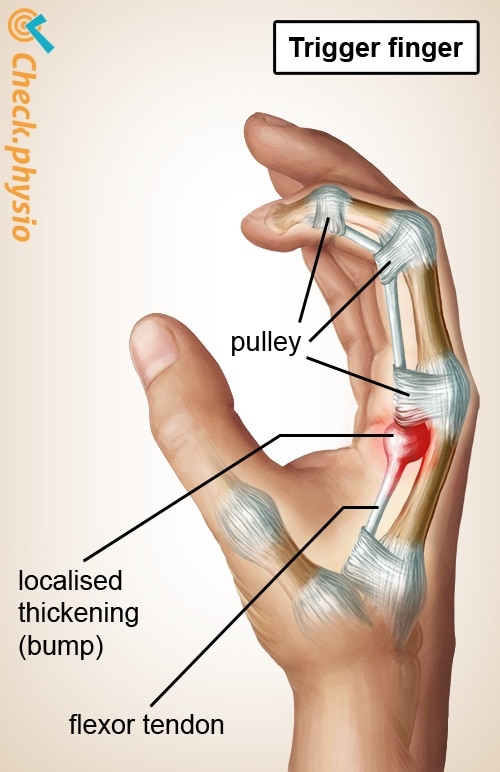Trigger finger
Stenosing tenosynovitis / trigger thumb
Trigger finger is a condition where it is difficult to extend the finger and the finger then unlocks with a snap. It is caused by localized thickening of the tendon that slides through a narrow tunnel in the hand.

If the thumb is affected, we call this trigger thumb.
Description of condition
The tendons that flex the fingers are located on the front of the hand. They run through small tunnels called "pulleys". The pulleys ensure that the tendon remains in position and that forces are passed on.
If localized thickening (a lump) forms in the flexor tendon, then this lump may not fit inside the tunnel. This causes the finger to "lock", particularly when extending the finger. In such situations, the flexor tendon is pulled toward the finger tips like a rope, meaning that the lump has to pass through the tunnel. There is some initial resistance and then it passes through the tunnel suddenly.
The problem is almost always in the tunnel that is located just below the base of the finger. However, the patient feels as if the symptoms are caused higher up, because the tendon moves the finger joints located higher up.
Cause and history
Trigger finger is more common in women. It is more common in the 40 to 70 age category and in children under the age of 6.
The symptoms usually start with an annoying or painful sensation just below the base of the finger. Next, the normal smooth movement of the flexor tendon is inhibited when the person bends or stretches the finger. The thickened tendon that is pulled through the pulley causes pain and results in the typical trigger finger effect.
The area also becomes more inflamed, because the tendon becomes trapped in the pulley. This in turn causes further swelling, making it even more difficult for the tendon to move through the pulley. Resulting in a vicious circle.
Signs & symptoms
- Pain along the front of the hand, just below the base of the finger.
- The finger locks when trying to extend and then snaps into place suddenly.
- In some cases, the finger remains in the bent position and can no longer be extended.
- The base of the finger may feel swollen.
Diagnosis
Treatment
If the symptoms developed very recently, a wait-and-see approach should be implemented first. If no improvement occurs, you could consider administering a corticosteroid injection (anti-inflammatories). This yields improvement in most cases. If this does not provide relief either, the pulley can be cut through surgically so that the tendon can move smoothly again.
Exercises
You can check your symptoms using the online physiotherapy check or make an appointment with a physiotherapy practice in your locality.
References
Peters-Veluthamaningal, C., Willems, W., Smeets, J.G.E., Windt, D.A.W.M. Van der, Spies, M.N., Strackee, S.D., Vos, K., Wind, L.A. & Geraets, J.J.X.R. (2010). NHG-Standaard. Hand- en polsklachten. Huisarts Wet. 2010:53(1):22-39.
Verhaar, J.A.N. & Linden, A.J. van der (2005). Orthopedie. Houten: Bohn Stafleu van Loghum.


